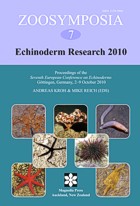Abstract
Suction has usually been regarded as the primary functional mean for attachment in sea star and sea urchin tube feet and this hypothesis has become widespread in the public knowledge. Yet, a few studies have suggested that adhesive secretions may also play a prominent role in tube foot attachment. Here we use a morphological and biomechanical approach to investigate the role of suction in asteroid and echinoid tube foot attachment. Microscopic observations of tube feet rapidly fixed while they were attached to a smooth substratum show that their distal surfaces are totally flat and lack a suction cavity. Detachment force and tenacity of a single tube foot appear to be independent of the pulling angle: i.e., the introduction of a shear component in the pulling force does not decrease attachment strength as would be expected for a sucker. Moreover, sea urchin tube feet attach as strongly to perforated surfaces, which preclude pressure reduction, as to their unperforated counterparts. Taken together, these results clearly show that echinoderm tube feet rely on adhesive secretions and not on suction.

